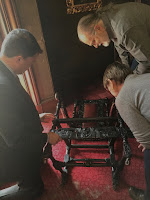This post is the first of a three-part series on the life and writings of Charles Hammond Gibson, Jr., founder of the Gibson House Museum. Stay tuned for parts two and three in the coming months.
 |
Gibson in his rose gardens |
How does one measure a life dedicated to poetry, a writing life? Charles Hammond Gibson, Jr. dedicated his entire adult life to the art of poetry, as poet, critic, editor, and literary personality. He published his first poem in the Boston Transcript in 1894, and, toward the end of his career, he quipped to a curious listener at one of his many public readings, “My dear lady, I have been writing poems for fifty years. They are like the droppings of pigeons all over the house.” His manuscripts overflowed from portfolios, closets, desk drawers, cabinets, drawing rooms, and even toolsheds! In some ways, Gibson’s poetry was closely connected to the domestic spaces he crafted, curated, and inhabited--his “Victorian Museum,” the Gibson House, and the spectacular gardens of his family’s exclusive summer residence, Forty Steps, Nahant. Like many traditional poets of the late nineteenth and early twentieth centuries, Gibson’s work is highly context-dependent. His poems tend to be formal, referential, commemorative, and backward-looking--vintage before their time--the kind of poetry that was almost completely obscured by the advent of literary modernism. On the other hand, viewed holistically, there is a compelling sense of quirky humor, passion, historicity, and mystery about Gibson’s writing, a body of work peppered with veiled autobiographical fragments that conceal as much as they reveal.

